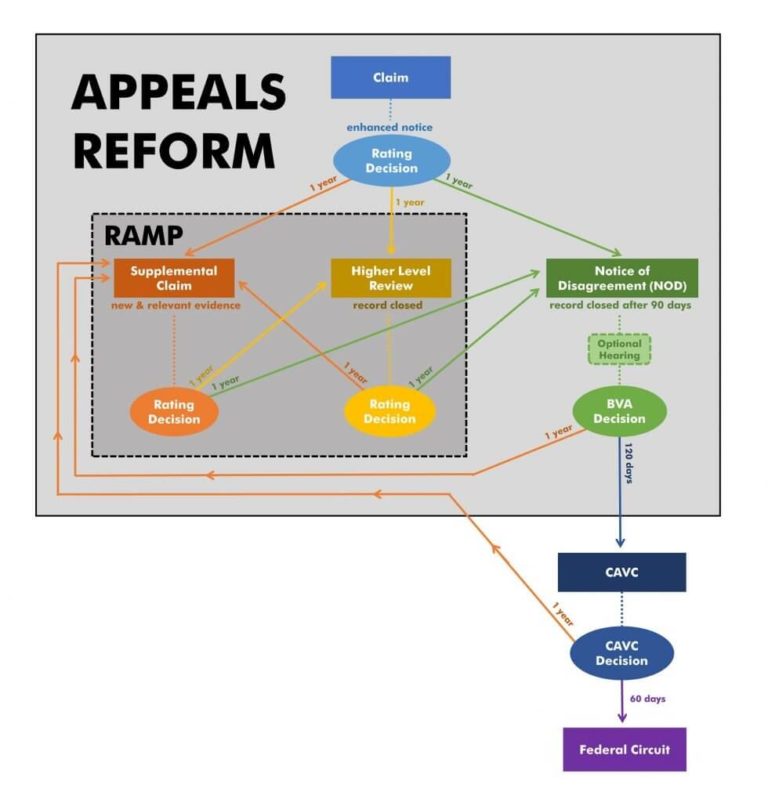VA Releases November 2018 Report on its Comprehensive Plan for Appeals Reform

CCK Law: Our Vital Role in Veterans Law
Comprehensive Plan for Processing of Legacy Appeals and Implementing the New Appeals System
VA’s November 2018 report is the fifth in a series of reports that satisfies the requirements of the Veterans Appeals Improvement and Modernization Act of 2017 (“Appeals Modernization Act”), which became law in August of 2017. The Appeals Modernization Act serves to revamp the entire VA disability appeals process in order to provide veterans, their families, and their survivors with increased choice in handling disagreements with VA’s decisions. Furthermore, it sets forth specific elements that must be addressed in VA’s comprehensive plan, including: implementing the new appeals system; timely processing under the new appeals system; and monitoring the implementation of the new appeals system, including metrics and goals. The report reflects all updates that have occurred within those areas. Overall, the main goal of VA’s comprehensive plan is to eliminate the inventory of legacy appeals as quickly as possible while also maintaining timely processing under appeals reform.
Processing of Legacy Appeals
The Veterans Benefits Administration
The Veterans Benefits Administration (“VBA”) is currently employing several strategies to reduce the pending inventory of its legacy appeals, including: workload redistribution across Regional Offices (“ROs”), increased oversight and accountability, dedicated resources, increased efficiencies by leveraging technology, and opt-in opportunities made available through the Rapid Appeals Modernization Program (“RAMP”). As a result of these strategies, VBA has increased the number of ROs participating in RAMP from 8 to 12 to keep up with the increasing number of opt-ins. Specifically, there were approximately 60,000 RAMP opt-ins from November 2017 to September 2018, broken down as follows:
- Higher-Level Review Claims
- 20,445 claims currently pending (55% of all RAMP claims)
- 14,040 claims completed, resulting in $60,202,396.20 paid to date
- 2% of claims granted, versus 72.8% of claims denied
- 3% of issues granted, versus 81.7% of issues denied
- Supplemental Claims
- 16,710 claims currently pending (45% of all RAMP claims)
- 4,749 claims completed, resulting in $20,393,892.05 paid to date
- 4% of claims granted, versus 71.6% denied
- 7% of issues granted, versus 82.3% of issues denied
By the end of September 2018, RAMP elections produced approximately $80,596,288 in retroactive benefits paid to veterans on 18,789 completed claims.
Additionally, such strategies have contributed to a 14.5 percent reduction of the legacy appeals inventory since the beginning of Fiscal Year (“FY”) 2018 alone, and a total decrease of 23 percent overall. Furthermore, VBA has seen an increase in the production of legacy appeals action by 9.2 percent.
VBA’s main goal in the processing of legacy appeals is to reduce the legacy inventory to a “steady state” in FY 2020. Here, a steady state is defined as the elimination of all legacy inventory in the NOD and VA 9 stages, with an inventory of remands that equals the number of appeals resolved per year. The November 2018 report estimates that 400 full-time employees will be required to maintain the steady state.
The Appeals Management Office
The Appeals Management Office (“AMO”) has also played a role in the simultaneous handling of both appeals under the legacy system and the new appeals system. Specifically, the AMO began brokering legacy appeals from the ROs participating in RAMP. The AMO distributes these appeals to other ROs by considering a station’s inventory, the average days to process each stage of the appeal, and the number of full-time employees. Importantly, the November 2018 report indicates that VA’s Budget for FY 2019 Budget allocates resources to hire an additional 605 full-time employees. The new hires will be placed primarily at newly created Decision Review Operations Centers located in St. Petersburg, Florida and Seattle, Washington.
The Board of Veterans’ Appeals
By September 2019, there should be approximately 95 Veterans Law Judges, 809 decision writing attorneys, and 225 support staff at the Board. However, this report states that all Board personnel will likely spend a percentage of their time working on both legacy appeals and appeals in the new system.
The Board plans to continue to build on its success from FY 2018 when it issued 85,288 decisions to veterans. The Board finished with 137,383 legacy appeals in its pending inventory, more than 28,000 appeals lower than its original projection. Further, this number of decisions not only exceeded the Board’s goal, but also represented an increase of 33,277 decisions from FY 2017. Nonetheless, the goal for FY 2019 is now set for 90,050.
Implementing the New Appeals System
VA continues to take coordinated steps to prepare for implementation of the new appeals system in February 2019. Representatives from various departments including VBA, the Board, Veterans Health Administration (“VHA”), and the National Cemetery Administration (“NCA”) meet regularly to collaborate and resolve issues. In their meetings, the group assesses VBA’s progress towards modernization initiatives, provides regular updates, exchanges ideas and best practices, identifies risks, and offers further guidance.
VA is continuing to use RAMP to test and evaluate the implementation of the new appeals system. The report indicates that not only does RAMP reduce legacy appeals inventory, but it also allows VA to collect data on the efficiency and effectiveness of the new framework. The Board is also running two test programs including the beginning of adjudication of RAMP appeals and the continuing adjudication of Board’s Early Applicability of Appeals Modernization (BEAAM) appeals. BEAAM is a small-scale research program that partners with veterans who are dissatisfied with a recent claim decision. The veterans are able to make elections under the new framework of appeals reform and will receive decisions consistent with the option that they choose. The purpose is to allow the Board to collect preliminary data about veterans’ preferences, choices, and experiences.
Based upon veteran feedback, the Board recently contracted with VA’s Veterans Experience Office to conduct surveys of veterans who have an active appeal at the Board. Again, this provides the Board with important comparative data regarding the veteran experience, and it can also be reviewed to assist with program improvement and implementation by informing the Board’s policies and procedures. Ultimately, the main goal under this component of VA’s comprehensive plan is to integrate and synchronize all appeals reform implementation plan efforts across the Department of Veterans Affairs.
Timely Processing Under New Appeals System
In regards to the specific timelines under the new appeals system, VBA’s goal is to maintain an average of 125 days to complete both higher-level review and supplemental claims. The Board is prioritizing legacy appeals and appeals in the new system’s “direct” docket. Its target for the average processing time of direct docket appeals remains 365 days, as the direct docket option does not involve the submission of new evidence or a hearing. However, appeals in the new system’s hearing and evidence dockets will be subject to longer wait times.
Legacy appeals must be decided in order according to docket date, which is based on the date of receipt of a VA 9 substantive appeal. Additionally, they retain their original docket date after a remand by the Board. On the other hand, appeals under the new framework must be decided in the order they are received on each docket. Nevertheless, under both the legacy and new framework, cases may be advanced on their docket due to the Veteran’s age, illness, financial hardship, or other reasons, and remands are still handled expeditiously.
In order to maintain this level of timeliness, VA anticipates a minimum of 10 percent of the Board’s workforce capacity will be applied to the Appeals Modernization Act framework. The Board’s main priority in this regard is to offer complete transparency regarding the wait times with each docket. Accordingly, VA plans to publish the projected wait times for each docket after implementation, based on early results, and will provide regular updates.
Monitoring Metrics and Goals of New Appeals System
The metrics and goals for the new appeals system continue to indicate that VA is on track for implementation in February 2019. VA has reviewed all of the comments from the public in response to the proposed regulations and will now work to complete the final rule Federal Register notice. However, the report acknowledges that additional time may be required to update guidance following publication of the final regulations. VA also anticipates, additional rulemaking after February 2019 to optimize both claims and appeals rules and processes.
Education Regarding Appeals Reform
As there is a significant amount of information circulating about the new appeals system, VA is developing resources in an effort to help educate both veterans, their families, and veterans’ advocates. Namely, the Board has collaborated with Veterans Service Organizations (“VSOs”) to develop a joint training on the Appeals Modernization Act to assist representatives in guiding veterans through the new claims and appeals process. This training will likely occur after the finalization of the regulations. Additionally, the Education Service has developed a communication and outreach plan to ensure veterans are aware of the new system as well. This plan includes the following:
- A fact sheet outlining the new appeals process
- E-mailing veterans who have received a decision letter in 2018 explaining the new appeals process
- Posting informational updates via VBA social media platforms both 60- and 30- days prior to enactment of the new law, as well as on the day of enactment
- Updating call center scripts for veterans who contact the call center for information regarding the new appeals system
About the Author
Share this Post
